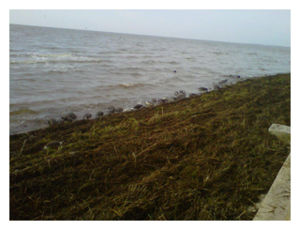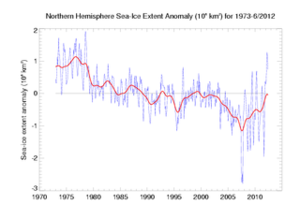|
|
Lisa Guliani
Sott.net 2012-09-03 05:55:00
What makes us 'special'? Is it our selfishness, our self-absorbed, mentally lazy non-critical sleepwalking zombie approach to life? Is it our capacity for sculpted selective empathy-on-demand - as long as the subject we empathize with falls within specific parameters and is...one of US? What makes US so 'special'? We watch as our tax dollars pay for illegal wars, assassinations, drug running, money laundering, illegal invasion and occupation, theft of land and resources in other nations, the Israeli government's ongoing ethnic cleansing of Palestinians, we watch as our tax dollars are used to further racial segregation, torture, arrest and detainment, brutality, home demolitions, apartheid, and genocide. We watch as our tax dollars are used to wipe out innocent men, women, and children in foreign lands that have raised no hand against us. What is so 'special' about us? |
|

|

|
George Monbiot
The Guardian 2012-09-03 09:45:00
Desmond Tutu has helped us see the true nature of what the former prime minister did to Iraq and increased pressure for a prosecution For years it seems impregnable, then suddenly the citadel collapses. An ideology, a fact, a regime appears fixed, unshakeable, almost geological. Then an inch of mortar falls, and the stonework begins to slide. Something of this kind happened over the weekend. When Desmond Tutu wrote that Tony Blair should be treading the path to The Hague, he de-normalised what Blair has done. Tutu broke the protocol of power - the implicit accord between those who flit from one grand meeting to another - and named his crime. I expect that Blair will never recover from it. The offence is known by two names in international law: the crime of aggression and a crime against peace. It is defined by the Nuremberg principles as the "planning, preparation, initiation or waging of a war of aggression". This means a war fought for a purpose other than self-defence: in other words outwith articles 33 and 51 of the UN Charter. |
|

|

| Puppet Masters |
|
Rebecca Greenfield
This morning AntiSec released
a list of 1 million out of 12 million Apple UDID's that it said it got
from the FBI, which has raised many questions, most prominently perhaps:
Just what was the FBI doing with that data in the first place? First
off, neither the FBI nor Apple has confirmed that the data released so
far is real. Update: Just after we published this post, the FBI issued a statement to Gizmodo
denying that the data came from them. "At this time, there is no
evidence indicating that an FBI laptop was compromised or that the FBI
either sought or obtained this data."The Atlantic Wire 2012-09-04 16:20:00 Before that statement, an FBI spokesperson told Computer World and Gizmodo that it was "declining to comment," which has led Gizmodo's Jamie Condliffe and Sam Biddle to suggest "it's very much possible that an FBI computer is the original source of this alleged data dump." Even though we have no proof of that, others have at least confirmed that the UDIDs out there correspond to actual phones, with ArsTechnica's Jacqui Cheng posting responses from Security journalist Rob Lemos and "eCrime specialist" Peter Kruse saying that they have devices on the list. With so little information -- AntiSec has refused to give interviews, for now -- we still can't be sure that these came from the FBI. But if the hackers are to be believed (an admittedly big if), it brings us back to that initial question: What did the FBI want with those Apple IDs? Some theories. |

|

|
Fars News Agency
2012-09-04 01:24:00
Al-Qaeda, backed by Turkey, the US and its regional Arab allies, has set up a new camp in Northern Waziristan in Pakistan to train Salafi and Jihadi terrorists and dispatches them to Syria via Turkish borders, sources said. "A new Al-Qaeda has been created in the region through the financial and logistical backup of Turkey, Saudi Arabia, Qatar and a number of western states, specially the US," the source told FNA. Ali Mahdian told FNA that the US and the British governments have been playing with the al-Qaeda through their Arab proxy regimes in the region in a bid to materialize their goals, specially in Syria. He said the Saudi and Qatari regimes serve as interlocutors to facilitate the CIA and MI6 plans in Syria through instigating terrorist operations by Salafi and Arab Jihadi groups, adding that the terrorists do not know that they actually exercise the US plans. "Turkey has also been misusing extremist Salafis and Al-Qaeda terrorists to intensify the crisis in Syria and it has recently augmented its efforts in this regard by helping the new Al-Qaeda branch set up a camp in Northern Waziristan in Pakistan to train Al-Qaeda and Taliban members as well as Turkish Salafis and Arab Jihadis who are later sent to Syria for terrorist operations," said the source. | |
|
Comment: "..Saudi and Qatari regimes serve as
interlocutors to facilitate the CIA and MI6 plans in Syria through
instigating terrorist operations by Salafi and Arab Jihadi groups,
adding that the terrorists do not know that they actually exercise the
US plans.."
Actually it is quite likely the CIA and MI6 know these Al-Quada and other alleged terrorist groups members - on a first name basis. Mossad vs Assad? 'CIA death squads behind Syria bloodbath' CIA, MI6 agents direct massacres in Syria: American analyst Syria Is A Convenient Fallguy Syria's Bloody CIA Revolution - A Distraction? |
|

|


|
Martin Walker
United Press International 2012-09-04 13:08:00
There have been three striking developments in different parts of the world in recent days, each of them with sobering implications for the global economy. Taken together, the prognosis is grim.The first was the speech of Fed Chairman Ben Bernanke at the annual bankers' gathering in Jackson Hole, Wyo., in which he acknowledged that U.S. unemployment as unacceptably high, which meant growth was well below par and that therefore more quantitative easing could be expected. Since the previous rounds of QE didn't succeed in reviving the economy (although they may have staved off more decline) it isn't clear why a third round should do the trick. Although stock markets predictably rallied at the prospect of more cheap money and continued low interest rates (which means investors might hope to do better in stocks than in bonds) Bernanke's real motive may have been as much political as economic. He is buying time and keeping the show on the road until such time as the politicians get their act together and reach a rational compromise on spending cuts and tax rises. |
|

|

| Society's Child |
|
Kati Whitaker
BBC News 2012-09-01 17:08:00
Kukuo, Northern Ghana - When misfortune hits a village, there is a tendency in some countries to suspect a "witch" of casting a spell. In Ghana, outspoken or eccentric women may also be accused of witchcraft - and forced to live out their days together in witch camps. A rusty motorbike speeds across the vast dry savannah of Ghana's impoverished northern region, leaving a cloud of reddish dust in its wake. Arriving at a small group of round thatched huts, the young motorcyclist helps his old mother to dismount to begin her new life in exile. Frail 82-year-old Samata Abdulai has arrived at the village of Kukuo, one of Ghana's six witch camps, where women accused of witchcraft seek refuge from beating, torture or lynching. The camps are said to have come into existence more than 100 years ago, when village chiefs decided to establish isolated safe areas for the women. They are run by tindanas, leaders capable of cleansing an accused woman so that not only is the community protected from any witchcraft but the woman herself is safe from vigilantes.
Today they are still run by local chiefs, and accommodate up to 1,000 women in spartan huts with no electricity or running water, and roofs that leak. For water, the inhabitants of the Kukuo camp walk three miles each day to the River Otti, struggling back uphill with heavy pots of water. It's an intolerable way for an elderly woman to live, but it's a life they are prepared to endure so long as they are safe. They survive by collecting firewood, selling little bags of peanuts or working in nearby farms. Samata lived some 40km (24 miles) away in the village of Bulli. There she spent her autumn years caring for her twin grandchildren while her daughter worked in the fields. |
||

|

|
NBC News
Manufacturing shrank at its sharpest clip in more than three years in
August, the third month of contraction in a row, and firms hired the
fewest workers since late 2009, a survey on Tuesday showed.2012-09-04 13:48:00 The Institute for Supply Management said its index of national factory activity fell to 49.6 in August from 49.8 in July. The reading fell shy of the 50.0 median estimate in a Reuters poll of economists. A reading below 50 indicates contraction in the sector. The index's employment component fell to 51.6, the lowest since November 2009, from 52.0 in July. "It is without question a soft report on manufacturing and what is particularly disconcerting is that the new orders index deteriorated again," said Tom Porcelli, chief U.S. economist for RBC Capital Markets. "It has become increasingly clear that the manufacturing sector is losing momentum. This soft report leading into Friday's payrolls will only solidify additional action from the Fed if we see another soft jobs report." New orders, a forward-looking sub-index, fell to 47.1 in August, the worst showing since April of 2009. It stood at 48 in July. The exports index ticked up to 47 last month from 46.5 in July but remained in contraction territory as recession in parts of Europe and slower growth in Asia sapped demand for U.S. goods. "Given everything we see internationally in terms of demand for our manufacturers, a little slowdown is to be expected, especially with the euro zone still under pressure and emerging economies experiencing relatively slow growth," said Patrick O'Keefe, director of economic research at J.J. Cohn. "Domestically, new orders for manufacturing were up a bit but not robustly so it isn't unexpected to see something a bit more cautious." Reuters contributed to this report. |
|
Comment: Manufacturing has been down for three or four years, not months.
We hope you're preparing for what is to come. The following will help. Social Harmony in Times of Global Dischord |

|

| Secret History |
|
Aliye Bekir
Simferopil/Aqmescit - A Ukrainian scientist discovered the oldest
pyramid in the world. Most interestingly, it was found in the most
beautiful corner of the country, in Crimea.Crimea News Agency (QHA) 2012-08-31 17:57:00 As the ICTV channel reported, the finding was revealed by accident, when during his test alternative methods of finding water Ukrainian scientist Vitalii Goh discovered underground unknown object, which proved to be a giant pyramid of 45 meters in height and a length of about 72 meters. Goh said that the pyramid was built during the time of the dinosaurs. "Crimean pyramid" has a truncated top, like a Mayan pyramid, but its appearance is more like an Egyptian. It is hollow inside, and a mummy of unknown creature is buried under the foundation. "Under the foundation is a small body in the form of a mummy long 1.3-1.4 meters with a crown on his head." "There is a resonance chamber of so-called Sphinx. The pyramids were built in the era of the dinosaurs," says the scientist in an interview with ICTV. It remains unknown who build the pyramid. The unique building is the oldest on the planet, says Vitalii Goh. |

|

|
ScienceDaily
2012-08-28 00:00:00
Max Planck researchers have described the Denisovan genome, illuminating the relationships between Denisovans and present-day humans. The analyses of an international team of researchers led by Svante Pääbo of the Max Planck Institute for Evolutionary Anthropology in Leipzig, Germany, show that the genetic variation of Denisovans was extremely low, suggesting that although they were present in large parts of Asia, their population was never large for long periods of time. In addition, a comprehensive list documents the genetic changes that set apart modern humans from their archaic relatives. Some of these changes concern genes that are associated with brain function or nervous system development. In 2010 Svante Pääbo and his colleagues sequenced DNA that they isolated from a finger bone fragment discovered in the Denisova Cave in southern Siberia. They found that it belonged to a young girl of a previously unknown group of archaic humans that they called "Denisovans." Thanks to a novel technique which splits the DNA double helix so that each of its two strands can be used for sequencing, the team was able to sequence every position in the Denisovan genome about 30 times over. The thus generated genome sequence shows a quality similar to genomes that have been determined from present-day humans. In a new study, which is published in this week's issue of the journal Science, Svante Pääbo and his colleagues compare the Denisovan genome with those of the Neandertals and eleven modern humans from around the world. Their findings confirm a previous study according to which modern populations from the islands of southeastern Asia share genes with the Denisovans. In addition, the genomes of people from East Asia, and South America include slightly more genes from Neandertals than those of people in Europe: "The excess archaic material in East Asia is more closely related to Neandertals than to Denisovans, so we estimate that the proportion of Neandertal ancestry in Europe is lower than in eastern Asia," the Leipzig researchers report. "This is an extinct genome sequence of unprecedented accuracy," says Matthias Meyer, the lead author of the study. "For most of the genome we can even determine the differences between the two sets of chromosomes that the Deniosovan girl inherited from her mother and father." From this the researchers can tell that genetic variation of the Denisovans was lower than in present-day humans. This is likely due to that an initially small Denisovan population that grew quickly while spreading over a wide geographic range. "If future research of the Neandertal genome shows that their population size changed over time in similar ways, it may well be that a single population expanding out of Africa gave rise to both the Denisovans and the Neandertals," says Svante Pääbo, who led the study. |
|

|

| Science & Technology |
|
Stephanie Pappas
LiveScience 2012-09-04 15:44:00
The aftermath of Hurricane Isaac has washed ashore tens of thousands of dead "swamp rats," invasive species whose rotting corpses are now presenting a health hazard in Mississippi. The drowned rodents, known as nutria, are a stark reminder of the effects of hurricanes on wildlife, which can range from mass death to - surprisingly enough - dolphin baby booms. In the case of the nutria, the drownings may be a blessing for the Gulf Coast, where the beaver-like creatures wreck havoc on native marsh vegetation. The clean-up, though, is proving unpleasant. "They're actually starting to swell up and bust," Hancock County Supervisor David Yarborough told local news station WLOX. "It smells really bad." |
|

|

|
Nola Taylor Redd
Space.com 2012-09-04 15:26:00
Meteoroids streaking through the atmospheres of planets such as Earth, Mars and Venus can change these worlds' air, in ways that researchers are just now beginning to understand. Most planetary atmospheres are made up of simple, low-mass elements and compounds such as carbon dioxide, oxygen and nitrogen. But when a debris particle, or meteoroid, passes through, it can shed heavier, more exotic elements such as magnesium, silicon and iron. Such elements can have a significant impact on the circulation and dynamics of winds in the atmosphere, researchers say. "That opens up a whole new network of chemical pathways not usually there," said Paul Withers of Boston University. |
|

|

|
Ernesto Guido, Nick Howes & Giovanni Sostero
M.P.E.C. 2012-Q72, issued on 2012 Aug. 28, reports the discovery of the PHA asteroid 2012 QG42 (discovery magnitude 16.8) by Catalina Sky Survey on images taken on August 26.3 with a 0.68-m Schmidt + CCD.Remanzacco Observatory 2012-09-04 13:38:00 2012 QG42 has an estimated size of 200 m - 500 m (H=20.4) and it will have a close approach with Earth at about 7.43 LD (Lunar Distances) or 0.019 AU at 0510 UT on 14 Sept. 2012. This asteroid will reach an average magnitude of 13.6 around September 10-12. 2012 QG42 is a current radar target for ground based radio telescopes. Astronomers at Goldstone and Arecibo will try to observe it on September as "this object should be a really strong delay-Doppler imaging target". It was classified as a PHA ((Potentially Hazardous Asteroid). PHA are asteroids larger than approximately 100m that can come closer to Earth than 0.05 AU. None of the known PHAs is on a collision course with our planet, although astronomers are finding new ones all the time. We performed some follow-up measurements of this object, remotely from the Siding Spring-Faulkes Telescope South on 2012, September 04.5, through a 2.0-m f/10.0 Ritchey-Chretien + CCD. Below you can see our image, stack of 4x10-second exposures, taken with the asteroid at magnitude ~15.2 and moving at 4.35"/min. At the moment of the close approach on 14 September, 2012 QG42 will move at ~ 49"/min.
Here you can see a short animation showing the movement of 2012 QG42 (each frame is a 10-second exposure). |
|

|

|
SpaceDaily
2012-09-03 22:16:00
This composite image shows a superbubble in the Large Magellanic Cloud (LMC), a small satellite galaxy of the Milky Way located about 160,000 light years from Earth. Many new stars, some of them very massive, are forming in the star cluster NGC 1929, which is embedded in the nebula N44, so named because it is the 44th nebula in a catalog of such objects in the Magellanic Clouds. The massive stars produce intense radiation, expel matter at high speeds, and race through their evolution to explode as supernovas. The winds and supernova shock waves carve out huge cavities called superbubbles in the surrounding gas. X-rays from NASA's Chandra X-ray Observatory (blue) show hot regions created by these winds and shocks, while infrared data from NASA's Spitzer Space Telescope (red) outline where the dust and cooler gas are found. |
|

|

|
Annalee Newitz
10,000 years ago, at a time when humans recorded historical events by
telling mythical stories that got passed from one generation to the
next, huge parts of the North American continent were deluged by massive
walls of water. They were, as geologist David R. Montgomery writes in this month's Discover magazine,
"Biblical-type floods." Huge regions of the Pacific Northwest, called
the "scablands" were chewed up by flash floods that were more like
tsunamis. And it was all caused by the melting of the glaciers from the
last ice age. As the walls of ice damming lakes melted away, the waters
would rush out across the land.io9 2012-09-03 22:11:00
|
|

|

|
ScienceDaily
Astronomers took advantage of the most distant supernova of its type to
probe a galaxy some 9.5 billion light years away. The light from the
exploding star, discovered by Pan-STARRS with followup spectroscopic
observations by the Gemini North telescope and the Multiple Mirror
Telescope, confirmed that the gas environment between the stars in the
distant galaxy is "reassuringly normal".2012-08-30 00:00:00 An international research team, led by Edo Berger of Harvard University, made the most of a dying star's fury to probe a distant galaxy some 9.5 billion light-years distant. The dying star, which lit the galactic scene, is the most distant stellar explosion of its kind ever studied. According to Berger, "It's like someone turned on a flashlight in a dark room and suddenly allowed us to see, for a short time, what this far-off galaxy looks like, what it is composed of." The study, published recently in The Astrophysical Journal, describes how the researchers used the exploding star's light (called an ultra-luminous core-collapse supernova) as a probe to study the gas conditions in the space between the host galaxy's stars. Berger says the findings reveal that the distant galaxy's interstellar conditions appear "reassuringly normal" when compared to those seen in the galaxies of our local universe. "This shows the enormous potential of using the most luminous supernovae to study the early universe," he says. "Ultimately it will help us understand how galaxies like our Milky Way came to be." The discovery of the dying star in this distant galaxy was made using images from the Pan-STARRS1 survey telescope on Haleakala in Maui, Hawai'i. "These are the types of exciting and unexpected applications that appear when a new capability comes on line," said John Tonry, one of the study's co-authors and supernovae researcher at the University of Hawai'i at Manoa's Institute for Astronomy. Tonry adds, "Pan-STARRS is pioneering a new era in deep, wide-field, time-critical astronomy -- and this is just the beginning." After the Pan-STARRS discovery, spectroscopic follow-up studies using the Multiple Mirror Telescope in Arizona and the 8-meter Gemini North telescope on Mauna Kea, Hawai'i provided the data used by the team to probe the gas of the distant galaxy's interstellar environment. |

|

| Earth Changes |
|
PerthNow
2012-09-04 17:11:00
Thousands of homes were without power across Perth this afternoon in the aftermath of a cold front that lashed the city today. A Western Power spokeswoman said thousands of homes had without power at different times during the day, but the number was steadily decreasing. Midland, Upper Swan and Pickering Brook were the worst affected areas. Many home owners are tonight counting the cost of damage caused by the storm. |
|

|

|
ONE News
2012-09-05 16:51:00
A severe weather watch is in place for Canterbury today, after Christchurch was hit by freakish weather last night leaving conservatories damaged and lifting a roof off a house. Emergency services in Christchurch were kept on their toes when lightning, thunder, rain and hail the size of golf balls hit the region shortly after 6pm. It finished just after 7pm. MetService said that the weather watch covers the possibility of northwesterlies gusting to severe gale strength at times in inland parts of Canterbury, Otago and Southland from late Wednesday through Thursday. |
|

|

|
Teresa Watanabe and Scott Gold
Los Angeles Times 2012-09-03 16:21:00
Authorities battling a wildfire in the Angeles National Forest more than doubled their deployments Monday, with 700 firefighters attacking the blaze with air tankers and helicopters. But it will probably take several more days to fully contain the fire, which has burned 3,600 acres in the San Gabriel Mountains north of Azusa, said John D. Wagner, a spokesman for the U.S. Forest Service. He said the steep terrain made firefighting difficult. The blaze remained about 5% contained late Monday. "It's not really accessible by foot, so we have to do air drops over the area," Wagner said. |
|

|

|
BBC News
2012-09-03 16:13:00
Portugal has said it is seeking European Union help to to tackle raging forest fires, in one of the worst summers for such blazes in years. Dozens of fires are raging in the centre and north of the country and 1,700 firefighters have been deployed. |
|

|

|
Paul Homewood
Not a Lot of People Know That 2012-09-04 16:09:00
Last week the website "Ice Age Now" posted the above graph in their article "Arctic Ice Hits Record Low!" shout global warming activists" The graph was from the UK Met Office website and tracks monthly anomalies in NH sea ice, which clearly show ice extent recovering from the 2007 minimum. Intrigued, I asked the Met Office for their comments and received the following reply from John Kennedy, a Research Scientist :- A look at the Met Office web page, that John mentions, explains :- |
|

|

|
Stephanie Pappas
About 9 percent of New York state water wells contain enough dissolved methane to require monitoring and other safety measures, according to a new study.LiveScience 2012-09-04 14:03:00 The research tested more than 200 wells used for drinking water across the state for the explosive gas, which is naturally occurring but can be dangerous if ignited. In 2 percent of wells, methane levels were so high that the gas needed to be vented off to avoid potential detonation. "The research is important because it raises the awareness of the natural quality of people's drinking water," study leader William Kappel, a hydrologist with the U.S. Geological Survey (USGS), said in a statement. "Well owners should work with local health departments to understand the quality of their drinking water to know if methane or other chemicals are present." |

|

|
Deacon Greg Kandra
Unbelievable.It happened in West Yorkshire in Northern England. I
suspect that after it happened, he not only had to replace his car
window, but probably had to replace his underwear, too.Patheos 2012-09-03 22:00:00 Details: A man cheated death by seconds when a freak lightning bolt sent a tree branch hurtling through the rear of his car. Bernard Williams had just removed his gym bag from the boot during a rainstorm when the bolt hit an adjacent willow tree catapulting a 10-foot long piece of wood across the road. The branch smashed into the car's back window - directly where Bernard had been standing - and ended up in the alleyway next to the house after taking a tail light with it.See how it happened below. |

|

|
Newsroom Panama
Two young girls, one of them pregnant, were struck by lightning and
killed on Sunday September 2 in the remote community of La Chumicosa on
Sunday. The girls, aged 10 and 16 were sitting under a mango tree
watching a football game in Olá district of Cocle. Witnesses said there
had been drizzle, but no stormswhen lightning struck the tree, killing
the two girls.2012-09-03 22:07:00 The local deputy who visited the scene, called for a public awareness program. to help the population understand precautions to be taken when there is thunder and lightning. |

|

|
The Indian Express
2012-09-03 22:04:00
Three people died after they were struck by lightning in Rajkot district as heavy rains lashed many parts of the state, including Kutch and Saurashtra, regions on Monday. Many parts of Saurashtra received up to 75 mm rainfall in the last 36 hours. Jamnagar recorded 65 mm, Amreli 77 mm, Junagadh 40 mm and Gondal in Rajkot 75 mm of rainfall, district control room said. Police said Devgan Jhala (14) and his cousin Kisan Jhala (13) were working in their field at Kotda Sanghani in Rajkot when lightning struck them. The duo sustained serious injuries and were taken to Rajkot Civil hospital where they died, said Dr Harsha Patel. In another incident, a farmer was killed by lightning when he was working in his farm in Jagdan town of the district, officials said. Meanwhile, heavy rain accompanied by thunderstorm lashed Ahmedabad and nearby areas on Monday evening, leading to waterlogging which disrupted vehicular movement at many places. |
|

|

| Fire in the Sky |
|
lunarmeteoritehunters.blogspot.com
Several (?) meteor events reported September 3rd over Texas, Oklahoma and Arkansas.2012-09-04 07:47:00 From the times and reported directions of travel it is hard to make heads or tails of these events; perhaps more sighting reports will help clear up the picture. Initial Reports 03 SEP 2012 Mike Denton, TX USA 2130 CDT 03 SEP 2012 Jane dunbar Bartlesville, OK. USA 21:15:00 03 SEP 2012 David Harrison, AR 21:10, CDT |

|

| Health & Wellness |
|
Anthony Gucciardi
NaturalSociety 2012-09-03 13:34:00 The latest study to demonize foods free of GMO ingredients and mercury-containing high-fructose corn syrup ultimately once again fails to accurately address key aspects of the conventional verses organic debate and even falls short of properly addressing the limited scope of concerns it does attempt to analyze. You can see even from the comments on many of the mainstream reports that readers quickly saw through the eroneous 'organic is the same as conventional' headlines and began highlighting the many inaccuracies of the research. As I outline in the video, the study completely fails to account for key factors such as the presence of GMOs, artificial sweeteners like aspartame and sucralose, mercury (such as that admittedly contained in high-fructose corn syrup), BPA, and much more. It also does not even properly address the two topics it seeks to address concerning the presence antibiotics and chemical residue. The researchers fail first of all to reveal the difference between the organic food and conventional food pesticides, and then go on to state that organic food actually does have lower pesticide levels. |

|

|
Case Adams
Greenmedinfo.com 2012-09-04 08:16:00
Two recent studies - one from Oregon State University and another from the University of Maryland's School of Medicine - have determined that lower blood levels of the "sunshine vitamin" - vitamin D (serum 25-hydroxyvitamin D (25(OH)D)) - equates to earlier death and greater incidence of frailty later in life. The most recent study, led by Dr. Ellen Smit, an assistant professor at Oregon State, analyzed 4,731 adults over the age of 60 years old. The study followed the adults for twelve years using data from the Third National Health and Nutrition Examination Survey. The researchers measured the adults' levels of frailty, gauged by low body mass, exhaustion, general weakness, slower walking and reduced physical activity. The randomized study's methodology, intended to represent the general U.S. elderly population, also followed death rates and correlated them with serum vitamin D levels. |
|

|

|
Dave Mihalovic
Prevent Disease.com 2012-09-04 02:06:00
A comparison of fetal-loss reports in the Vaccine Adverse Event Reporting System (VAERS) during three consecutive influenza seasons shows there was a synergistic toxicity causing spontaneous abortions (SAB) and stiillbirths (SB) following the Center for Disease Control (CDC) recommendations of pandemic and influenza vaccines administered to pregnant women. An overwhelming majority of pregnant women who visit the doctor's office are now refusing the flu vaccine over fears it will harm their fetus and their fears are now scientifically justified. More than 90% of all expecting mothers will now say no to the flu vaccine due to fear of miscarriage and delivery of toxic byproducts to their unborn child. In 2011, Dr. Alessandro Bertoucci who analyzed the practices of 256 physicians treating more than 600,000 patients, reported that a staggering 91% of pregnant women are declining influenza vaccines due to fears of miscarriage and suspected toxins in the vaccine itself. A study published last year in the Human and Experimental Toxicology journal found a direct statistical correlation between higher vaccine doses and infant mortality rates. It was a confirmation that many anti-vaccine advocates have long awaited and further establishes and adds to preliminary evidence that vaccinations are toxic poisons having no place in the human body. The study, Infant mortality rates regressed against number of vaccine doses routinely given: Is there a biochemical or synergistic toxicity?, was conducted by Gary S. Goldman and Neil Z. Miller who has been studying the dangers of vaccines for 25 years. The infant mortality rate (IMR) is one of the most important indicators of the socio-economic well-being and public health conditions of a country. The US childhood immunization schedule specifies 26 vaccine doses for infants aged less than 1 year--the most in the world--yet 33 nations have lower IMRs. Australia and Canada are a close 2nd and 3rd respectively with 24 vaccine doses. Some countries have IMRs that are less than half the US rate: Singapore, Sweden, and Japan are examples. According to the Centers for Disease Control and Prevention (CDC), "The relative position of the United States in comparison to countries with the lowest infant mortality rates appears to be worsening." |
|

|

|
ScienceDaily
2012-08-28 00:00:00
When Thomas Edison tested the first light bulb in 1879, he could never have imagined that this invention could one day contribute to a global obesity epidemic. Electric light allows us to work, rest and play at all hours of the day, and a paper published this week in Bioessays suggests that this might have serious consequences for our health and for our waistlines. Daily or "circadian" rhythms including the sleep wake cycle, and rhythms in hormone release are controlled by a molecular clock that is present in every cell of the human body. This human clock has its own inbuilt, default rhythm of almost exactly 24 hours that allows it to stay finely tuned to the daily cycle generated by the rotation of Earth. This beautiful symmetry between the human clock and the daily cycle of Earth's rotation is disrupted by exposure to artificial light cycles, and by irregular meal, work and sleep times. This mismatch between the natural circadian rhythms of our bodies and the environment is called "circadian desynchrony." The paper, by Dr. Cathy Wyse, working in the chronobiology research group at the University of Aberdeen, focuses on how the human clock struggles to stay in tune with the irregular meal, sleep and work schedules of the developed world, and how this might influence health and even cause obesity. "Electric light allowed humans to override an ancient synchronization between the rhythm of the human clock and the environment, and over the last century, daily rhythms in meal, sleep and working times have gradually disappeared from our lives," said Wyse. "The human clock struggles to remain tuned to our highly irregular lifestyles, and I believe that this causes metabolic and other health problems, and makes us more likely to become obese." |
|

|

|
ScienceDaily
2012-08-30 00:00:00
Scientists have found that calorie restriction -- a diet composed of approximately 30 percent fewer calories but with the same nutrients of a standard diet -- does not extend years of life or reduce age-related deaths in a 23-year study of rhesus monkeys. However, calorie restriction did extend certain aspects of health. The research, conducted by scientists at the National Institute on Aging (NIA) at the National Institutes of Health, is reported in the August 29, 2012 online issue of Nature. Calorie restriction research has a long history. The first finding came in the 1930s, when investigators observed laboratory rats and mice lived up to 40 percent longer when fed a calorie-restricted diet. Subsequent research has cited calorie restriction as extending lifespan of yeast, worms, flies and some strains of mice. But other studies have not shown a longevity benefit. For example, in studies of certain strains of mice, calorie restriction on average had no effect on lifespan. Some of these mice actually had a shorter lifespan when given a calorie-restricted diet. To date, research does not provide evidence that calorie restriction is an appropriate age regulator in humans, the NIA investigators point out. Currently, limited human studies are under way to test the effectiveness and safety of calorie restriction in people. The survival results in the study reported Aug. 29 by NIA researchers differ from those published in 2009 by NIA-supported investigators at the University of Wisconsin-Madison. The Wisconsin study followed two groups of rhesus monkeys for 20 years and found that monkeys on a calorie-restricted diet lived longer than those on a standard diet. |
|

|

|
Science Daily
2012-08-30 00:00:00
In the foothills of the Santa Cruz Mountains two closely related species of mice share a habitat and a genetic lineage, but have very different social lives. The California mouse (Peromyscus californicus) is characterized by a lifetime of monogamy; the deer mouse (Peromyscus maniculatus) is sexually promiscuous. Researchers at the University of California Berkeley recently showed how these differences in sexual behavior impact the bacteria hosted by each species as well as the diversity of the genes that control immunity. The results were published in the May 2012 edition of PLoS One. Monogamy is a fairly rare trait in mammals, possessed by only five percent of species. Rarely do two related, but socially distinguishable, species live side-by-side. This makes these two species of mice interesting subjects for Matthew MacManes, a National Institutes of Health-sponsored post-doctoral fellow at UC Berkeley. Through a series of analyses, MacManes and researchers from the Lacey Lab examined the differences between these two species on the microscopic and molecular levels. They discovered that the lifestyles of the two mice had a direct impact on the bacterial communities that reside within the female reproductive tract. Furthermore, these differences correlate with enhanced diversifying selection on genes related to immunity against bacterial diseases. Bacteria live on every part of our bodies and have distinctive ecologies. The first step of MacManes project involved testing the bacterial communities that resided in the vaginas of both species of mice -- the most relevant area for a study about monogamous and promiscuous mating systems |
|

|

|
ScienceDaily
2012-09-01 00:00:00
Flying high, or down in the dumps -- individuals suffering from bipolar disorder alternate between depressive and manic episodes. Researchers from the University of Bonn and the Central Institute of Mental Health in Mannheim have now discovered, based on patient data and animal models, how the NCAN gene results in the manic symptoms of bipolar disorder. The results have been published in the current issue of The American Journal of Psychiatry. Individuals with bipolar disorder are on an emotional roller coaster. During depressive phases, they suffer from depression, diminished drive and often, also from suicidal thoughts. The manic episodes, however, are characterized by restlessness, euphoria, and delusions of grandeur. The genesis of this disease probably has both hereditary components as well as psychosocial environmental factors. The NCAN gene plays a major part in how manias manifest "It has been known that the NCAN gene plays an essential part in bipolar disorder," reports Prof. Dr. Markus M. Nöthen, Director of the Institute of Human Genetics at the University of Bonn. "But until now, the functional connection has not been clear." In a large-scale study, researchers led by the University of Bonn and the Central Institute of Mental Health in Mannheim have now shown how the NCAN gene contributes to the genesis of mania. To do so, they evaluated the genetic data and the related descriptions of symptoms from 1218 patients with differing ratios between the manic and depressive components of bipolar disorder. |
|

|

| Science of the Spirit |
|
Activist Post
Isn't it obvious that there is a significant global awakening happening?
Just as the Mayans predicted so many years ago, the apocalypse would
become apparent in 2012. But many misinterpret the apocalypse to be the
end of the world, when in fact it actually means an "un-covering, a
revelation of something hidden."2012-09-03 20:12:00 As many continue to argue the accuracy of the Mayan calendar, it can no longer be argued that a great many people are finally becoming aware of what has been hidden from them for so long. Of course this awakening is not an overnight process. It takes time to peel away the many layers of lies to get to the core of the ultimate truths. It would be beyond pretentious for us to claim to know all of the secrets of the universe. We don't. Everyday we are humbled by what we don't yet know. However, it is becoming clearer by the day what isn't true. And by that measure alone, it is possible to determine if you're one of the people beginning to wake up. |

|

|
George Dvorsky
io9 2012-09-03 08:00:00
Researchers working at MIT have successfully manipulated the content of a rat's dream by replaying an audio cue that was associated with the previous day's events, namely running through a maze (what else). The breakthrough furthers our understanding of how memory gets consolidated during sleep - but it also holds potential for the prospect of "dream engineering." Working at MIT's Picower Institute for Learning and Memory, neuroscientist Matt Wilson was able to accomplish this feat by exploiting the way the brain's hippocampus encodes self-experienced events into memory. Scientists know that our hippocampus is busy at work replaying a number of the day's events while we sleep - a process that's crucial for memory consolidation. But what they did not know was whether or not these "replays" could be influenced by environmental cues. To see if this could be done, Wilson and his team trained a group of rats to run through a maze using two distinct audio cues. The rats quickly learned that the tones were helpful; one sound indicated that food could be found by going left, while the other sound indicated that a food reward awaited them on the right. And while the rats were doing this, the neuroscientists were recording their neural activity. |
|

|

|
LiveScience
2012-09-04 09:28:00
Guys' eyes are more sensitive to small details and moving objects, while women are more perceptive to color changes, according to a new vision study that suggests men and women actually do see things differently. "As with other senses, such as hearing and the olfactory system, there are marked sex differences in vision between men and women," researcher Israel Abramov, of the City University of New York (CUNY), said in a statement. Research has shown women have more sensitive ears and sniffers than men. "[A] recent, large review of the literature concluded that, in most cases females had better sensitivity, and discriminated and categorized odors better than males," Abramov and colleagues write Tuesday (Sept. 4) in the journal Biology of Sex Differences. Abramov and his team from CUNY's Brooklyn and Hunter Colleges compared the vision of males and females over age 16 who had normal color vision and 20/20 sight - or at least 20/20 vision with glasses or contacts. In one part of the study, the researchers asked the volunteers to describe different colors shown to them. They found that the guys required a slightly longer wavelength of a color to experience the same shade as women and the men were less able to tell the difference between hues. |
|

|

|
ScienceDaily
2012-08-30 00:00:00
Crises are said to bring people closer together. But a new study from UC Berkeley suggests that while the have-nots reach out to one another in times of trouble, the wealthy are more apt to find comfort in material possessions. "In times of uncertainty, we see a dramatic polarization, with the rich more focused on holding onto and attaining wealth and the poor spending more time with friends and loved ones," said Paul Piff, a post-doctoral scholar in psychology at UC Berkeley and lead author of the paper published online this month in the Journal of Personality and Social Psychology. These new findings add to a growing body of scholarship at UC Berkeley on socio-economic class -- defined by both household income and education -- and social behavior. Results from five separate experiments shed new light on how humans from varying socio-economic backgrounds may respond to both natural and human-made disasters, including economic recessions, political instability, earthquakes and hurricanes. They also help explain why, in times of turmoil, people can become more polarized in their responses to uncertainty and chaos. For example, when asked if they would move across the country for a higher-paying job, study participants from the lower class responded that they would decline in favor of staying close to friends, family and colleagues. By contrast, upper class participants opted to take the job and cut ties with their community. Although the study does not provide a definitive reason for why the upper class, when stressed, focuses more on worldly goods than relationships, it posits that "material wealth may be a particularly salient, accessible and preferred individual coping mechanism ... when they are threatened by perceptions of chaos within the social environment." Each experiment was done with a different group of ethnically and socio-economically diverse participants, all of whom reported their social status (household income and education) as well as their level of community mindedness and/or preoccupation with money. |
|

|

| High Strangeness |
|
Deanna Allen
A moving, flashing light. Centered over the Barrow County jail but not remaining stationary. A UFO?Barrow Patch 2012-09-03 08:46:00 A report posted on UFO Stalker, a website that tracks reported UFO sightings throughout the country, indicated a recent sighting in Winder. The following information was submitted on Saturday, Sept. 1, 2012, regarding the sighting Friday, Aug. 31. We were driving from barrow county to gwinett county and saw a strange flash in the sky. At first we thought it was police lights. When we got closer we realized it was in the sky over the jail and moving toward tennesee. The light was flashing but not staying in the same place. There were as many as four at a time but never in the same arrangement. It looked like one large light and 3 smaller lights.This follows a report of unidentified flying objects in Bethlehem this past May and in Winder in April. |






























